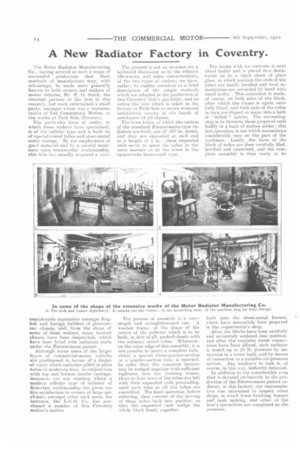A New Radiator Factory in Coventry.
Page 16

If you've noticed an error in this article please click here to report it so we can fix it.
'The Motor Radiator Manufacturing Co., having arrived at such a stage of successful production that their ainethods of manufacture may, with advantage, be made more generally known to both owners and makers of motor vehicles, Mr. P. O. Serck, the resident partner of the firm in this Kssuntry, last week entertained a small party, amongst whom was a representative of THE COMMERCIAL MOTOR, at the works at Park Side, Coventry.
The particular form of cooler, in which these makers have specialized, is of the cellular type and is built up 44 special round tubes and sheet-metal enter casings. By the employment of good material and by a careful insistence upon trustworthy workmanship, -this firm has steadily acquired a very considerable reputation amongst English and foreign builders of pleasurecar chassis, and, from the shops of some of these makers, ninny taxicab chassis have been despatched, which have been fitted with radiators made under the Zimmermann patent. Although many users of the larger types of commercial-motor vehicles are predisposed in favour of a design ea cooler which embodies gilled or plain tubes of moderate bore, in conjunction with top and bottom header castings, instances are not wanting where a modern cellular type of radiator of first-class workmanship has given entire satisfaction to owners of large machines; amongst other such users, for instance, the L.G.O. Co. has purchased a number of this Coventry maker's coolers.
The present is not an occasion for a technical discussion as to the relative efficiencies, and other characteristics, of the two types of coolers; we have, rather, to confine ourselves to a brief description of the simple methods which are adopted in the production of this Coventry firm's speciality, and to notice the care which is taken in the factory at Park Side to insure eventual satisfactory service in the bands of purchasers of all classes.
The brass tidies. of which the centres of the standard Zimmermann-type radiators are built, are of .005 in. metal, and they are expanded at each end to a length of in. ; these expanded ends serve to space the tubes in the same manner as do the wires in the square-tube honeycomb type.
The process of assembly is a verysimple and straightforward one. A wooden frame, of the shape of the centre of the radiator which is to be built, is, first of all, packed closely with the ordinary round tubes. Wherever, on the outer edge of this assembly, it is not possible to insert a complete tube, either a special three-quarter-section or a quarter-section tube is inserted. In order that this complete battery may be wedged together with sufficient tightness into the forming frame, three or four rows of the tubes are !eft with, their expanded ends protruding, until such time as all the tubes are assembled. The final operation, before soldering, then consists of the driving of these tubes hack into position, so that the expanded ends wedge the whole block firmly together. The Ironic with its contents is next lifted bodily and is placed face downwards on to a thick sheet of plate glass, in which position the ends of the tubes are finally levelled and local indentations are corrected by hand with small drifts. This correction is made, of course, on both sides of the block, after which the frame is again (,arefully lifted, and both ends of the tubes in turn are dipped en .masse into a bath of " killed " spirits. The succeeding step is to immerse these prepared ends bodily in a bath of molten solder ; this last operation is one which necessitates considerable care on the part of the workman. Lastly, the faces of the block of tubes are then carefully filed, levelled and examined, and the complete assembly is then ready to be built into the sheet-metal frames, Nvhich have meanwhile been prepared in the coppersmith's shop.
After the blocks have been carefully and accurately soldered into position, and after the requisite water connections have been affixed, each radiator is tested up to 25 lb. pressure by immersion in a water bath, and by means of connection to a suitable air-pressure service. Any tendency to leak is, of course, in this way, instantly detected.
In addition to the considerable area that is devoted exclusively to the production of the Zimmermann patent radiator, in this factory, our representative was interested to inspect other shops, in which brass finishing, bonnet and tank making, and other of the firm's specialities are completed on the premises.
























